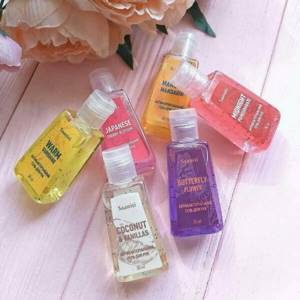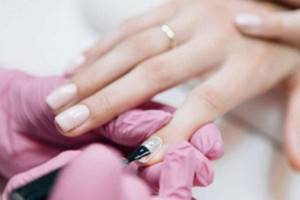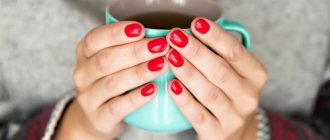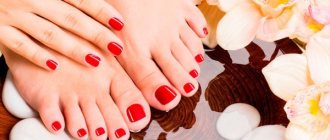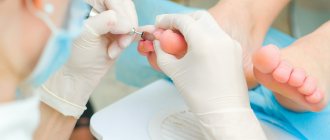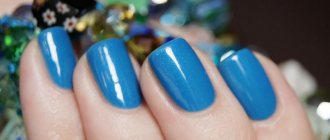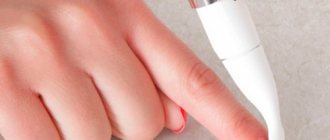- July 21, 2018
- Nail care
- Ksenia Stepanishcheva
Well-groomed nails can give you confidence. Therefore, many representatives of the fair sex spend a lot of time doing manicures. It is important to carry out procedures in a neat work area with clean equipment. How to disinfect manicure instruments at home is described in the article.
Nuances
Manicure is a procedure during which small particles of biomaterial remain on the instruments. Even a small drop of blood or an almost invisible scale contains harmful bacteria, viruses and other microorganisms. That is why it is necessary to know how to disinfect manicure instruments at home, as well as sterilize them.
These concepts must be distinguished. Disinfection is the treatment of surfaces and devices using special means to eliminate pathogens. But it will not allow you to get rid of pathogenic microbes. Sterilization eliminates all viruses, fungi, prions, bacteria and spores. High-quality processing of manicure products protects a person from fungi, skin ailments, suppuration, herpes, hepatitis B, and HIV.
Sterilization of manicure instruments: why is it so important
Any products that come into contact with the client's skin or nails can become a source of infection for serious diseases. This does not happen as rarely as it might seem at first glance. Even during the simplest procedures, the integrity of the tissue can be compromised - this also applies to microtraumas without traces of blood, invisible to the eye. Such damage becomes an open gate for bacteria, viruses, fungi and other microbes.
The most common types of diseases transmitted by contact include:
- viral infections (hepatitis B and C, human papillomavirus, HIV);
- bacterial (mainly staphylococcal and streptococcal);
- fungal (Pityrosporum ovale, Candida sp., Epidermophyton sp.);
- parasitic (various forms of helminths).
A microscopic amount of blood is enough to become infected with the hepatitis B or C virus, which affects more than 300 million people worldwide. They lead to liver cirrhosis, jaundice, cancer and even death. During manicure procedures in salons that do not sterilize instruments, you can also catch less dangerous diseases, for example, the well-known fungus. But it causes a lot of discomfort - the aesthetic appearance of the nails deteriorates, peeling and itching occur. Treatment and recovery take several months. It is much easier to sterilize the instrument after each client and carefully follow safety rules.
What instruments are disinfected?
The procedure should be applied to all tools that are used in manicure. Disinfection is performed for:
- scissors;
- wire cutter;
- pusher;
- nail brushes;
- baffy, nail files;
- manicure table, roller, bath;
- LED or UV lamps;
- dots;
- reusable forms.
It is also necessary to disinfect the room, the hands of the master and the client. First you need to determine how disinfection will be carried out - manually or using a device. Typically, the devices are used in salons, and manual processing is carried out at home. But you can also buy equipment for your home, especially if manicures are performed regularly.
Why are manicure kits sterilized and disinfected?
The rules for using manicure accessories are prescribed in SP 3.1.5.2826-10, SanPiN 2.1.2.2631-10. The requirements include 4 stages of processing: disinfection of used items, pre-sterilization cleaning (PSC), sterilization and storage of manicure instruments.
Sterilization of objects for manicure or pedicure is a measure to prevent the spread of infections. Pathogens are transmitted when a contaminated instrument comes into contact with a nail or with blood due to accidental damage to the skin.
According to the requirements of SanPiN, the master is obliged to disinfect his hands (his own and the client’s), workplace, and manicure tools.

Infection is possible through manicure tools:
- hepatitis C or B;
- herpes;
- HIV;
- nail and/or skin fungus;
- pyogenic microbes.
How often should the treatment be performed?
In nail salons, tools are processed after each client using special devices. Washing with water is not considered disinfection. When taking care of your nails yourself at home, wipe scissors and abrasive files with alcohol.
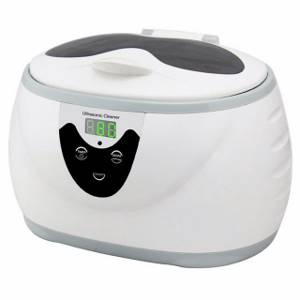
Every month you need to disinfect your manicure set in distilled boiled water. If the tools are used by more than one person, then boiling must be done before and after use. With the help of clean tools, performing a manicure will not only be safe, but also enjoyable.
What requirements for sterilization does SanPiN impose?
Requirements for cleanliness and processing are established by sanitary rules that replaced SanPiN - SP 2.1.3678-20. They say that all manicure and pedicure procedures that can damage the skin or nail plate must be performed by the master with sterile instruments.
Alternatively, a disposable instrument can be used. These are, for example, abrasive attachments for base files and buffs or sand caps. They are thrown away after each client.
According to sanitary rules, disinfection is carried out in stages. And we must not confuse disinfection and sterilization. The first refers to chemical cleaning, which is used to carry out primary processing. Sterilization of manicure instruments according to SanPin involves the destruction of all dangerous microorganisms.
Boiling
This is one of the popular methods for disinfecting manicure tools at home. This method was also used by asclepiads - ancient doctors used them for medical devices. Tools must be washed in advance with soapy water to remove any remaining skin, nails, and dirt. They are then placed in boiling distilled water and disinfected for about 20 minutes.
Then you need to remove it with tongs and place it on a prepared towel. The devices should dry naturally without cooling with cold water. A sharp change in temperature can ruin even reliable metal.
Boiling water disinfects tools, but not all metals can withstand this disinfection. Regular procedures affect the quality of tools: scissors become dull and small elements become deformed.
Stages of sterilization
The sterilization sequence must not be disrupted. It consists of several steps that cannot be combined with each other. Microbiological studies confirmed that after such treatment all known bacteria, viruses, fungi and parasites die. Consequently, the risk of contracting any disease is reduced to zero.
- The first step after using manicure accessories is preliminary disinfection using an ultrasonic cleaner or disinfectant solution.
- Then the instruments should be rinsed under running water and disinfected again in an ultrasonic bath.
- Next, the products must be washed in distilled water, dried and sealed in craft bags.
- The last step is heat treatment in an autoclave or dry-heat oven.
Each stage must be carried out in a separate place. It is also necessary to prepare a place to store used (dirty) and sterilized instruments. They cannot be in contact with each other, stored on the same shelf or on the same table.
Dry heat treatment
How to sterilize manicure tools in home tools in another way? Dry heat treatment of manicure devices is an affordable method. The procedure is similar to the actions before cooking in the oven:
- The oven is heated to 200 degrees.
- During this period, use warm soapy water to wash off the dirt and remnants of manicure work, and rinse with clean running water.
- Metal devices must be wiped dry and placed on a dry, clean baking sheet so that there is some distance between them.
- The products are left in the oven for 15 minutes.
- Then you need to turn off the oven, take out the baking sheet with an oven mitt and let the devices cool on their own.

This completes the procedure for sterilizing manicure instruments at home. The treatment allows you to clean the devices from germs so that the manicure is safe.
Medical alcohol
How to treat manicure tools? Before and after use, the device must be wiped with an alcohol solution, which removes dust and dirt. Microbes present on fertile soil will not escape from this procedure.
It is much more effective to disinfect manicure instruments at home by dipping them in an alcohol solution. You need to keep them like this for about 30 minutes. Having taken them out with tongs, you need to place them in a hermetically sealed bag and sign the date of disinfection.
Is it better to buy disposable files?
Disposable files are not disinfected, but are disposed of after a single use, that is, their presence relieves the master of some of the hassle and saves time. Therefore, with a large number of clients, many “manicure fairies” prefer to make do with them. These tools cost 3-9 rubles. for 50 pieces when purchasing in large quantities at once.
For regular clients, if there are few of them, it is better to have a set of reusable tools. Each one must be in a special package, which must be signed. But using files for only one client does not eliminate the need to process them.
Disinfection of manicure accessories is an important part of a nail technician’s work, but it is also important during home procedures. After all, with nails damaged by fungus or injury or infected skin, there can be no question of performing a design. Therefore, when buying tools, gel polishes, brushes, you should take care of purchasing disinfectant solutions, containers, and sterilizer.
Home sterilizer
Another way to disinfect manicure tools at home? If you have the financial means, you can purchase a special device that disinfects devices. A small container with a hermetically sealed lid affects bacteria with ultraviolet light. There are also devices that perform disinfection with hot steam.

Processing of files and attachments
How to disinfect nail file-shaped manicure tools at home? It is necessary to take into account the material from which they are made. It may be necessary to wipe with a cotton pad soaked in a special solution. The method is suitable for glass and metal files. They are also subjected to heat in the oven.
Paper and wood-based files are cleaned with a brush and antiseptic is sprayed on both sides. The cutters also need to be sterilized depending on the material. Rubber and silicone are subject to processing.
The best solutions for disinfection
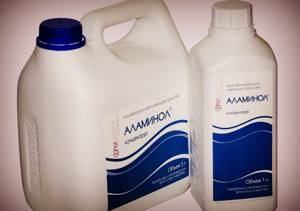
Both in the salon and at home, safety is the main thing. It’s not for nothing that sanitary stations impose huge fines on salons for untreated instruments. If long-established large salons have found their ideal disinfectant, then it is sometimes difficult for newcomers to decide. For home use, treatment products can also be useful. We will not go into detail about the consequences of an untreated tool for both the master and the client. Let's go straight to the review of the best solutions.
Estilodez
A cheap and effective product in demand on the market. It contains many surfactants and does not cause metal corrosion. Kills bacteria HIV, hepatitis, tuberculosis, pathogenic fungi. Suitable for processing not only tools, but also work surfaces and towels. Due to this, it is often used in medical institutions.
It is added to ordinary unboiled water in the required proportions, which determines the holding time in the solution. It must be diluted in glass or enamel containers.
For complete disinfection you will need:
- 0.1% - 1 hour;
- 0.2% - 30 minutes;
- 0.3% - 15 minutes;
- 0.4% - only 5 minutes.
Moreover, the product comes with special strips for determining the concentration.
MultiDez
Also a domestic cheap product. The chemical composition is much smaller, but this does not prevent it from performing the task perfectly. Fights most bacteria, fungi and viruses. It can be frozen and defrosted and does not cause any corrosive changes to the metal. The effectiveness of the drug allows it to be used in medical institutions, catering establishments and sports complexes.
To ensure that the product does not foam and lose its desired properties, it must be diluted correctly. To do this, the solution is added to warm water. Proportion 100:2.
Alaminol
Effectively fights many bacteria, fungi and viruses, including Candida fungi, rotoviruses and HIV. Does not have a corrosive effect on metal and is completely non-toxic. A plus is that if it gets on your skin, just wash it off with water. The fumes are also not harmful. The prepared solution can be used several times and stored for up to 10 days. The proportions for dilution are indicated on the bottle.
- A 1% solution is suitable for surface treatment.
- 3% for light virus treatment.
- 8% will cope with mushrooms and is suitable for complete disinfection. It will take 60 minutes.
Neosteril
This is a ready-to-use product. They are produced in three colors, depending on various additives: blue, colorless and orange. For nail salons, colorless and blue are more suitable. However, this product is used mainly for disinfecting hands, surfaces and tools immediately before use. It is also effective for treating cuts, as it also has healing properties. Despite the speed of action, it also copes well with fungi, viruses and bacteria, including HIV, rotoviruses and hepatitis. Does not require washing the instrument after use. The poles include that it does not cause irritation, allergic reactions and has an antiperspirant effect.
Desecon
A distinctive feature is that the higher the temperature of the water for the solution, the higher the effectiveness of the drug. Used for preliminary washing and disinfection of instruments. Fights various bacteria and viruses and thoroughly cleanses from skin residues, dirt, cream and oil.
Depending on the type of treatment, dilute to a concentration of 0.02% to 5%. For UV sterilizers, a 1.5% solution is sufficient. Ready solutions can be used repeatedly and stored for up to 30 days. In addition to various disinfectants, different methods of disinfection are also used.
Ball sterilizer
It is also called quartz. Presented in the form of a compact tabletop device designed for disinfecting instruments using high temperature.
A special feature of the device is that it disinfects not the entire instrument, but the area that comes into contact with the skin during the procedure. The operation of the device is based on heating quartz beads located in the sterilizer tank.

How to sterilize manicure instruments at home? Operating the device is simple:
- Before using the equipment for the first time, you need to open the lid and fill the tank with quartz balls, which are included in the kit.
- You need to close the lid and turn on the device with the button on the case.
- The device heats up to the required temperature - this is done for 10-12 minutes.
- After the indicator goes out, you need to open the lid and place the accessories into the device.
- After 15-20 seconds, you need to take them out and you can perform a manicure.
You need to use a sterilizer before using manicure devices. It quickly eliminates pathogenic microorganisms. But manicure products quickly become deformed. Such equipment can be used for devices made of heat-resistant medical alloy.
This equipment is usually used in salons, but it can also be purchased for home use. It is necessary to choose devices from trusted brands, and then the processing will be of high quality.
How to sterilize manicure tools at home
When seeing clients at home, it is necessary to clean supplies in the same way as in a salon. This needs to be done even if you are doing a manicure only for yourself - after each use, bacteria begin to multiply uncontrollably on the surface of the product. Even conditionally pathogenic flora can become a source of disease over time. Therefore, do not be lazy to purchase a compact sterilizer for home use. If you don't have one, metal tools can be placed in an electric or gas oven. In this case, you should set the maximum temperature and wait at least 30 minutes. They must first be washed under running water and dried with a disposable towel.
Effective means
How to treat manicure tools? Devices must undergo several degrees of purification from harmful microorganisms before being used for their intended purpose. Pre-sterilization cleaning involves removing particles of dead skin and biological fluids. It consists of washing tools in running water using regular soap.
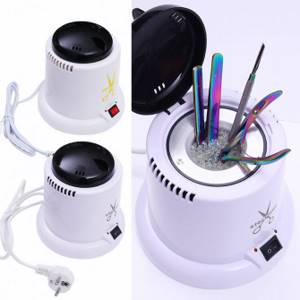
Clean accessories must be placed in a sterilizer and treated against bacteria and viruses. Then the products must be packaged in sealed bags. Before the procedure, they undergo the final stage of disinfection. It is also used for the workplace and hands of the master and client. To do this, use the following means:
- "Neosteril colorless." Used for express disinfection of surfaces and instruments. It contains alcohol, dries quickly and does not need to be rinsed off. The product has a wide spectrum of action. After the procedure, there is no need to ventilate the room. The product is also used when there are people in the room.
- "Neosteril blue." This is a hand disinfectant, presented in the form of a ready-made solution, which must be used to wipe the skin before the procedure. The liquid has a wound healing effect. It is considered safe and does not lead to allergies or skin irritations.
- “Dezecon”, “Dezefect”, “Dezecon-OM”. The products are used to disinfect manicure products. They have a similar effect, they are special disinfecting chemicals poured into the bath. Tools are placed in the container. After this, you need to rinse them with running water. “Dezecon” can be used for a month, “Dezefect” and “Dezecon-OM” - for 2 weeks, and then the solutions will be unusable and must be replaced.
These are the most popular products in demand among masters and beginners in manicure. They are suitable for processing various devices. On such products, the instructions indicate how to treat manicure tools at home. You need to follow it, and then you don’t have to worry about the safety of the devices.
Basic errors in tool processing
1. Only the tools are processed, and the master forgets about his hands or workplace.
It is very important that everything you or your client (or the friend you are doing a manicure) comes into contact with is perfectly clean, including your hands and all surfaces. Microorganisms live everywhere - to protect yourself and your client, always disinfect your hands and wear gloves when working.
|
If you are doing a manicure only for yourself, also treat your hands and all surfaces so that in case of a cut you can be sure that nothing will get into the wound.
2. Tools are treated only with alcohol or boiling water.
If you are doing a manicure only for yourself, then this treatment will be enough, but if you are working with other people, do not limit yourself to alcohol or boiling water. As we noted above, only sterilization, which requires very high temperatures, completely protects against harmful bacteria and viruses.
3. Tools are not stored correctly.
Store tools in airtight bags or containers, especially if they touch more than just your hands. Otherwise, the instruments will gather dust, and sterilization will be useless.
Recommendations
To make the procedure safe, you must follow simple rules:
- You should wait until the instruments cool down to prevent burns.
- You cannot cool the devices in cold water; they must cool down on their own, otherwise they may deteriorate.
- You should purchase antiseptics and sterilizers not based on price, but on quality and functionality. The action of cheap drugs is not aimed at eliminating all causative agents of various ailments.

Even if a manicure set is used at home, it must also be disinfected. The procedure eliminates bacteria and makes the devices suitable for further use.
The article presents all the ways to disinfect manicure tools at home. With their help, manicure will be a high-quality and safe procedure.
Types and composition
Hand sanitizers are available in several forms:
- spray;
- gel;
- antibacterial wipes.
Conveniently, the first two options are available in different dosages: a mini bottle is perfect for private use, and large volumes are suitable for frequent hand treatment (manicure and pedicure services).
Wipes are very convenient in moments of emergency disinfection. The main components of sanitizers are:
- ethyl alcohol (at least 80%);
- isopropyl alcohol (at least 75%);
- water (to reduce concentration);
- glycerin (to soften the aggressive effects of alcohol on the skin);
- essential oils (for a pleasant aroma and additional care).
The composition may also include chlorhexidine, hydrogen peroxide, triclosan and various parabens.
